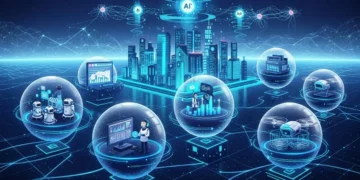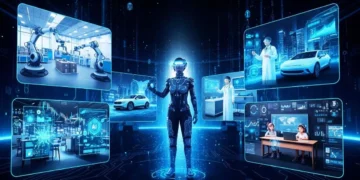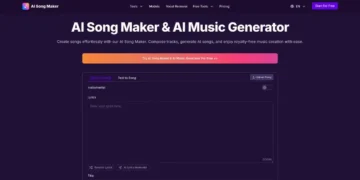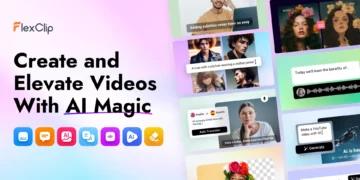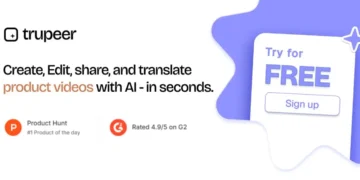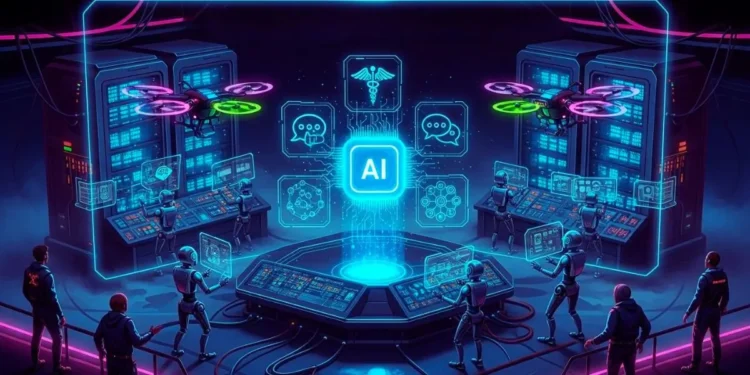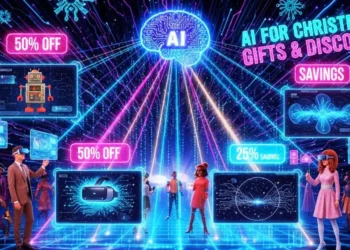Imagine a world where some of your most tedious daily tasks are handled seamlessly in the background. This isn’t science fiction—it’s our current reality. The artificial intelligence vs human intelligence debate often centers on a dramatic takeover, but the truth is far more nuanced.
While AI won’t replicate the full spectrum of human thought and emotion anytime soon, it has already surpassed us in numerous specific, everyday functions. This doesn’t render us obsolete; instead, it frees us to focus on what makes us uniquely human: creativity, strategy, and emotional connection.
When you wake up in the morning and ask your smart speaker about the weather, then use a budgeting app to track your spending, and later rely on a search engine to plan your vacation, you’re already leveraging artificial intelligence that in some cases surpasses human capabilities. The remarkable progress in AI isn’t just happening in research labs—it’s transforming our everyday experiences in ways we often don’t even notice. From how we work to how we relax, AI systems are demonstrating superhuman performance across a surprising range of daily activities.
According to Stanford University’s 2024 AI Index Report, AI has officially surpassed human performance in several benchmarks including image classification, visual reasoning, and English language understanding . Google’s Gemini Ultra became the first large language model to reach human-level performance on the Massive Multitask Language Understanding benchmark, scoring 90.0%—slightly above the human baseline of 89.8% . But what does this actually mean for your day-to-day life? How is artificial intelligence already reshaping ordinary tasks, and where does it truly outperform human efforts?
In this comprehensive guide, we’ll explore the practical, surprising, and sometimes unsettling ways AI is exceeding human capabilities in everyday contexts. Whether you’re a skeptic, an enthusiast, or simply curious about the future of AI, understanding these developments is crucial for navigating our rapidly changing world. Let’s dive beyond the hype and examine the tangible ways AI is already revolutionizing daily life.
What is Artificial Intelligence? A Quick Primer
Before we dive into the list, let’s briefly define our subject. Artificial intelligence is a branch of computer science focused on creating systems capable of performing tasks that typically require human intelligence. This includes learning, reasoning, problem-solving, perception, and language understanding .
The most common type of AI we interact with daily is called “narrow AI” or “weak AI.” These systems are designed and trained for one specific task, whether that’s recommending a movie, recognizing your face to unlock your phone, or filtering your email spam . They are masters of their single domain but cannot generalize their intelligence across different fields like humans can.
Understanding AI’s Capabilities: More Than Just Hype
Before we explore specific examples, it’s important to understand what we mean when we say AI can perform tasks “better” than humans. We’re typically referring to several key advantages:
Speed and Scale: AI can process information and execute tasks at speeds incomprehensible to humans
24/7 Availability: Unlike people, AI systems don’t need rest, breaks, or sleep
Consistency: AI maintains the same performance level regardless of mood, fatigue, or external factors
Pattern Recognition: AI can identify complex patterns across massive datasets that would overwhelm human cognition
However, it’s crucial to recognize that current AI systems primarily excel at specific, well-defined tasks rather than general intelligence. As one expert notes, “AI can perform specific tasks with precision and better than humans. But still, there are a lot of areas in AI that need improvement” .
Have you noticed AI systems handling certain tasks more efficiently in your own life? What surprised you most?
The 19 Areas Where AI Excels
1. Processing Vast Amounts of Data at Incredible Speeds
How fast can AI process information? The speed is almost incomprehensible. AI algorithms can analyze datasets that would take humans years to process in a matter of minutes or even seconds . This capability is revolutionizing fields like healthcare, where AI can review millions of medical images to identify patterns invisible to the human eye, and finance, where it can detect fraudulent transactions in real-time among millions of legitimate ones .
2. Maintaining Consistency in Repetitive Tasks
Unlike humans, AI systems don’t get tired, bored, or distracted. They can perform the same task with identical precision millions of times without variation. This makes them ideal for quality control in manufacturing, where they can inspect products for defects with unwavering attention , or in data entry, where they process information with near-perfect accuracy .
3. Recognizing Patterns and Anomalies
The human brain is good at pattern recognition, but AI is exceptional. From identifying subtle patterns in stock market fluctuations to detecting rare genetic mutations in DNA sequences, AI systems can spot correlations and outliers that would escape even the most trained human experts . This capability powers everything from predictive maintenance in industrial equipment to early disease detection in healthcare.
4. Providing 24/7 Customer Service
AI-powered chatbots and virtual assistants can handle customer inquiries around the clock without needing breaks, vacations, or sleep . They can simultaneously manage thousands of conversations, providing instant responses to common questions and freeing human agents to handle more complex issues that require empathy and nuanced judgment .
5. Delivering Hyper-Personalized Recommendations
When Netflix suggests your next binge-watch or Amazon recommends a product you actually want, you’re experiencing AI’s superior capability in personalization. These systems analyze your behavior, preferences, and similar users’ patterns to curate content and products with uncanny accuracy . They continuously refine their suggestions based on your interactions, creating an increasingly tailored experience.
6. Translating Languages in Real-Time
While human translators still excel at capturing cultural nuance and context, AI has become remarkably proficient at real-time language translation. Tools like Google Translate can instantly convert text between hundreds of languages, and AI-powered earbuds can facilitate near-real-time conversations between people speaking different languages, breaking down communication barriers in ways previously impossible .
7. Optimizing Route Planning and Navigation
Navigation apps like Google Maps and Waze use AI to analyze real-time traffic data from millions of users to calculate the fastest routes . They can predict traffic congestion, adjust for accidents or road closures, and even anticipate how traffic flow will change based on time of day—all while you’re driving. This continuous optimization saves commuters countless hours daily.
8. Detecting Financial Fraud
AI systems monitor credit card transactions in real-time, identifying suspicious patterns that might indicate fraud . By analyzing your spending habits alongside millions of other transactions, these systems can spot anomalies—like a purchase in a country you’ve never visited—and flag them instantly, often before you even realize your card has been compromised .
9. Automating Text Editing and Correction
The autocorrect feature on your smartphone is a common example of AI in everyday life. These systems use natural language processing to not only correct spelling based on dictionaries but also learn your personal writing style and frequently used words to provide more accurate predictions over time . More advanced tools like Grammarly use AI to analyze writing style, tone, and clarity beyond simple spelling and grammar.
10. Managing and Organizing Digital Photos
When your phone’s photo app automatically tags pictures with “beach,” “birthday,” or specific people’s faces, you’re seeing AI in action. These systems can sort through thousands of images, recognizing faces, objects, and scenes with accuracy that far exceeds what would be practical for humans to do manually . They can even enhance photos by analyzing and optimizing their visual elements .
11. Playing Complex Strategy Games
AI has repeatedly demonstrated superiority in complex games like Chess, Go, and StarCraft 2, often beating world champions . These games require strategic thinking, pattern recognition, and long-term planning—areas once considered exclusively human domains. The AI systems that master these games don’t just calculate moves; they develop innovative strategies that sometimes surprise their human creators.
12. Generating Content Quickly
From writing basic news reports to creating marketing copy and even generating computer code, AI can produce content at a speed and scale impossible for humans . While the creative quality and emotional depth may not always match human-generated content, AI tools like ChatGPT can rapidly produce first drafts, suggest alternatives, and handle routine writing tasks efficiently .
13. Performing Predictive Maintenance
In manufacturing and industrial settings, AI can analyze data from equipment sensors to predict when machines are likely to fail or need maintenance . This allows companies to address issues before they cause downtime, saving millions in lost productivity and repair costs. The AI identifies subtle patterns in vibration, temperature, or performance that human operators would likely miss.
14. Conducting Thorough Research Quickly
AI-powered research tools can scan thousands of academic papers, reports, and articles in seconds to find relevant information . While human judgment is still crucial for interpreting and synthesizing information, AI dramatically accelerates the information-gathering phase, allowing researchers, students, and professionals to focus their energy on analysis and insight rather than manual searching.
15. Driving Vehicles Safely in Controlled Environments
While fully autonomous cars aren’t yet ubiquitous, AI already handles significant portions of driving, particularly in predictable environments like highways. Advanced driver-assistance systems can maintain lane position, adjust speed based on traffic, and emergency brake more quickly than human reflexes allow . In controlled areas like warehouses, AI-powered vehicles already navigate complex routes efficiently and safely .
16. Screening Job Applications Efficiently
AI systems can rapidly analyze thousands of resumes and applications to identify candidates who best match job requirements . They can scan for specific skills, experiences, and qualifications far faster than human recruiters, helping to surface qualified candidates who might otherwise be overlooked in large application pools. This allows HR professionals to focus on interviewing and assessing cultural fit.
17. Monitoring Energy Consumption and Optimizing Usage
AI systems can analyze patterns in energy usage across buildings, factories, and entire cities to identify inefficiencies and optimize consumption . Smart thermostats like Nest learn your schedule and preferences to heat and cool your home efficiently, while utility companies use AI to balance grid load and integrate renewable energy sources more effectively.
18. Creating Realistic Synthetic Images and Media
Generative AI systems like DALL-E and Midjourney can produce realistic images, artwork, and even videos based on text descriptions . While the creative intent originates with humans, the execution speed and technical proficiency of these systems exceed human capabilities for similar tasks. This technology is revolutionizing fields from advertising to entertainment production.
19. Simulating Complex Scenarios for Training
AI can create highly realistic training simulations for everything from medical procedures to emergency response. These simulations can generate countless variations and scenarios, providing practice opportunities that would be too dangerous, expensive, or rare to recreate in the real world. Medical students, for example, can practice complex surgical procedures in risk-free virtual environments before operating on actual patients.
Professional and Productivity Tasks
Data Analysis and Pattern Recognition
When it comes to sifting through massive datasets to identify trends, correlations, and anomalies, AI already surpasses human capabilities by a significant margin. Human analysts might require weeks to process what AI can comprehend in minutes. For instance, AI tools can analyze customer behavior patterns across millions of transactions to identify subtle shopping trends that would escape human notice.
Google’s Gemini features an insanely large context window—supporting over 1 million tokens—allowing it to process and analyze lengthy documents and datasets in seconds . This capability enables businesses to make data-driven decisions faster than ever before. The economic impact of AI in this domain is substantial, with 42% of surveyed organizations reporting cost reductions and 59% reporting revenue increases through AI implementation .
Content Creation and Optimization
The revolution in generative AI has transformed content creation, with tools like ChatGPT demonstrating remarkable proficiency in generating drafts, ideas, and even optimized content. While human creativity remains essential for strategic direction and emotional resonance, AI can now handle the heavy lifting of initial drafting and SEO optimization.
Interestingly, 76% of marketers now use generative AI for creating content and drafting compelling copy . However, as SEO expert Connor Gillivan observes, “It will be a combination of humans + AI = the best SEO outcomes. It’s the SEOs that use AI tools to improve their quality of content that will end up winning” . This highlights that the most effective approach combines human creativity with AI efficiency.
Customer Service Responses
AI-powered chatbots and virtual assistants can handle routine customer inquiries with greater speed and consistency than human agents. They provide instant responses 24/7, simultaneously managing thousands of conversations while maintaining consistent quality and adherence to brand guidelines.
Tools like Cleo offer a conversational interface for personal budgeting, providing natural language insights into spending habits . The future of AI in customer service lies not in replacing humans entirely, but in handling routine queries so human agents can focus on complex, emotionally sensitive issues that require genuine empathy and nuanced understanding.
Personal Life and Daily Tasks
Meal Planning and Recipe Generation
If you’ve ever stared into your refrigerator wondering what to cook with random ingredients, AI has you covered. Tools like ChefGPT and Kitchen Assistant can generate creative recipe ideas based on whatever ingredients you have available, accommodating specific dietary restrictions and nutrition goals along the way .
These systems can analyze thousands of flavor profiles and cooking techniques to suggest combinations that might never occur to the average home cook. While a human chef brings intuition and cultural context, AI offers endless creativity without culinary bias. As one expert notes, AI is particularly strong at “optimizing travel routes, but humans still need to define the goals and interpret results” —the same principle applies to meal planning.
Personalized Fitness Coaching
AI fitness coaches like FitGPT can generate ultra-personalized workout plans based on your specific goals, current fitness level, available equipment, and even past injuries . These systems incorporate exercise science data from thousands of successful training regimens, adapting in real-time as you log your progress.
While a human trainer provides motivation and form correction, AI coaches offer unparalleled personalization and 24/7 availability. They can process more variables than any human possibly could, creating optimized routines that balance multiple fitness objectives simultaneously. This represents one of the most practical examples of how artificial intelligence is enhancing personal wellness.
Financial Management and Budgeting
Apps like Cleo and WallyGPT use conversational AI to help users track spending, identify savings opportunities, and maintain budgeting discipline . These systems can detect subtle spending patterns across your accounts that you might miss and provide data-driven recommendations for improving your financial health.
The AI can process market trends, interest rates, and your personal financial history to offer suggestions tailored to your specific situation. While human financial advisors still excel at complex strategic planning, for day-to-day money management, AI already surpasses human capabilities in pattern recognition and consistent monitoring.
Creative and Technical Tasks
Image Editing and Enhancement
AI-powered tools like Nano Banana (Google’s Gemini 2.5 Flash Image model) have revolutionized image editing, enabling complex transformations through simple text prompts . You can instantly change backgrounds, modify outfits, or even transform artistic styles—tasks that would require significant time and expertise in traditional editing software.
These systems have learned from analyzing millions of image edits, developing an understanding of visual aesthetics that often rivals human graphic designers for specific technical tasks. As one reviewer noted, “It covers nearly every kind of image editing you might need” , from quick touch-ups to complete scene transformations.
Video Creation and Editing
AI video generators like Synthesia allow anyone to create professional-looking videos with AI avatars speaking in multiple languages, while tools like OpusClip can automatically transform long videos into engaging short clips optimized for social media . These platforms analyze content to identify the most compelling moments, resize footage appropriately, and even add captions—tasks that would take human editors hours or days.
The future of AI in video production doesn’t eliminate human creativity but democratizes access to professional-looking results. As one user reported, “The AI feature is surprisingly effective at finding the best parts of a video, so I didn’t have to spend ages scrubbing through footage” .
Technical Optimization and Coding
In fields like software development, AI systems are demonstrating remarkable capabilities. Google’s AlphaDev AI discovered new, more efficient sorting algorithms that had eluded human experts for decades . These algorithms, fundamental to computer science, saw a 70% improvement in sorting speed for certain data types when integrated into the widely used C++ library.
Similarly, OpenAI’s GPT-4 achieves 96.3% accuracy on the HumanEval coding benchmark—a 30.4% improvement since the benchmark’s introduction in 2021 . While human developers remain essential for architectural decisions and understanding business context, for optimized code generation, AI already surpasses human capabilities in specific domains.
Specialized Applications
Travel Planning and Itinerary Optimization
AI-powered travel assistants like Expedia’s chatbot and Skyscanner’s planning tools act as virtual travel agents, sifting through countless combinations of flights, accommodations, and activities to find optimal matches for your preferences and budget . These systems can process more variables than any human travel agent could manage efficiently.
The technology “lets users create personalized travel itineraries and summarize guest reviews for quicker reading” , saving hours of research time. While human agents still excel at crafting uniquely personal experiences, for efficiency and comprehensive search capabilities, AI travel tools offer undeniable advantages.
Research and Information Synthesis
When you need to quickly understand a complex topic, AI research assistants can analyze and synthesize information from countless sources far more efficiently than humans. Google’s Gemini can process lengthy academic papers and provide concise summaries, with its audio overview feature offering “podcast-style, five-minute audio summary hosted by AI voices” —perfect for digesting complex information during commutes.
This capability represents one of the most significant ways artificial intelligence is enhancing human capabilities, acting as a research assistant that never tires and can process information at incredible speeds.
Home Design and Improvement Planning
Apps like AI Home Design Assistant allow you to visualize home improvement projects by uploading images of your space and testing different styles and configurations . These tools can generate realistic visualizations faster than human designers, enabling you to experiment with countless options before committing to any physical changes.
The technology is particularly valuable for landscape gardening, where you can “generate landscape gardening ideas from text prompts and bring them to life visually” . This instant visualization capability represents a significant advantage over traditional design processes.
Where Humans Still Reign Supreme: The Critical Balance
Now that we’ve explored what AI excels at, let’s address the natural follow-up question: How are humans better than AI? Despite AI’s impressive capabilities in specific domains, human intelligence remains vastly superior in several crucial areas that machines cannot easily replicate.
Identify three examples where you see humans as superior to AI systems:
Creative Innovation and True Originality: While AI can combine and remix existing ideas in novel ways, humans possess the ability for genuine creativity—imagining entirely new concepts, artistic movements, and scientific paradigms. The profound insight that leads to paradigm-shifting innovations like relativity or the invention of entirely new art forms remains a distinctly human capability .
Emotional Intelligence and Empathy: Humans excel at understanding nuanced social cues, showing genuine empathy, and building deep, trusting relationships. While AI can mimic empathy through programmed responses, it doesn’t genuinely understand or experience emotions. The human touch remains irreplaceable in therapy, leadership, negotiation, and caregiving .
Complex Ethical Reasoning and Moral Judgment: Humans can navigate ambiguous ethical dilemmas, understand context-dependent morality, and make judgment calls based on principles and values. AI systems operate on the data and rules they’re given, lacking genuine moral compass or the ability to understand the deeper philosophical implications of decisions .
Other areas of human superiority include adaptive learning across different domains (humans can quickly apply knowledge from one area to another), common sense reasoning, and strategic thinking in completely novel situations .
The Future of Human-AI Collaboration
Rather than viewing AI as a replacement, the most productive perspective is to see it as a collaborator. The future lies in human-AI collaboration, where each plays to their strengths. So what will AI get better at to help humans? Several key areas are emerging:
Augmenting Human Decision-Making: AI will increasingly provide data-driven insights and scenario analysis, while humans provide contextual understanding and ethical judgment .
Handling Tedious Aspects of Creative Work: AI will take over routine aspects of design, composition, and drafting, freeing human creators to focus on high-concept direction and refinement .
Personalizing Education and Healthcare: AI will enable truly personalized learning paths and treatment plans tailored to individual needs, learning styles, and genetic profiles .
Accelerating Scientific Discovery: AI will help researchers analyze complex datasets, simulate experiments, and identify promising research directions, dramatically accelerating progress in fields from medicine to materials science .
As this collaboration deepens, the question “Are humans artificial intelligence?” becomes more philosophical than technical. While we’re creating intelligent systems, human intelligence remains organic, consciousness-equipped, and driven by biological and emotional factors that AI doesn’t share.
Conclusion
The artificial intelligence vs human intelligence debate isn’t about which is universally better, but about recognizing their complementary strengths. AI excels at scale, speed, precision, and data-driven tasks, while humans bring creativity, empathy, ethics, and strategic thinking to the table.
The most successful individuals and organizations of the future won’t be those who choose between human and artificial intelligence, but those who master the art of human-AI collaboration. They’ll leverage AI to handle what it does best, freeing up human potential for what we do best: imagining, creating, connecting, and leading.
As you go about your day, notice the many examples of artificial intelligence in everyday life—from your morning weather forecast to your evening entertainment recommendations. How can you leverage these technologies to enhance your own capabilities? The future belongs not to AI or humans alone, but to the powerful synergy between them.
Frequently Asked Questions
What things can AI do better than humans?
AI currently performs better than humans in specific tasks that involve processing large volumes of data, recognizing complex patterns, maintaining consistency in repetitive tasks, operating 24/7 without fatigue, and making predictions based on data analysis. Examples include detecting financial fraud, providing personalized recommendations, translating languages in real-time, and optimizing navigation routes .
What are 5 common uses of AI in our daily lives?
Five common uses of AI that many people encounter daily include:
Digital Assistants: Siri, Alexa, and Google Assistant use AI to understand and respond to voice commands .
Social Media Feeds: Platforms like Facebook and Instagram use AI algorithms to curate your feed based on your interests .
Navigation Apps: Services like Google Maps and Waze use AI to analyze real-time traffic and provide optimal routes .
Streaming Recommendations: Netflix and Spotify use AI to suggest movies and music based on your viewing and listening history .
Smartphone Cameras: AI enhances photos by automatically detecting scenes and optimizing settings .
Why are AI better than humans in some areas?
AI is better than humans in specific areas primarily due to its superior processing speed, ability to analyze vast datasets without fatigue, unwavering consistency, and lack of cognitive biases in data analysis. AI systems can identify subtle patterns across millions of data points that would be impossible for humans to process efficiently . However, it’s crucial to remember that this superiority is limited to specific, well-defined tasks.
What are 5 positive impacts of AI?
Five significant positive impacts of AI on society include:
Increased Efficiency: AI automates routine tasks across industries, saving time and reducing costs .
Enhanced Decision-Making: AI analyzes complex data to provide insights that help businesses and individuals make more informed choices .
Advancements in Healthcare: AI assists in disease diagnosis, drug discovery, and personalized treatment plans .
Improved Safety: AI powers predictive maintenance in critical infrastructure and enhances vehicle safety features .
Personalized Experiences: AI tailors education, shopping, and entertainment to individual preferences and needs .
What is the difference between AI and human intelligence?
The fundamental difference lies in their nature and capabilities. Human intelligence is general, adaptive, and driven by consciousness, emotions, and experiences. It allows for creativity, common sense, and ethical reasoning. Artificial intelligence, particularly today’s “narrow AI,” is specialized, designed for specific tasks, and operates based on patterns in data and algorithms. It lacks genuine understanding, consciousness, and emotional experience .
Can AI ever achieve human-like consciousness?
Most experts believe that current AI, including advanced models like ChatGPT, is nowhere near achieving human-like consciousness. These systems excel at pattern recognition and generating human-like text based on their training data, but they lack self-awareness, genuine understanding, and subjective experience. This type of theoretical AI is known as Artificial General Intelligence (AGI), and it remains a long-term goal rather than a current reality .
What everyday tasks can AI do better than humans?
AI currently surpasses humans in several everyday tasks including data analysis, pattern recognition, personalized recommendations, 24/7 customer service, image editing, travel planning optimization, and financial pattern detection. These advantages stem from AI’s ability to process vast amounts of data quickly, operate continuously, and maintain consistent performance.
Will AI make human workers obsolete in these areas?
Not necessarily. While AI excels at specific technical tasks, most professional domains still require human judgment, creativity, emotional intelligence, and strategic thinking. The most effective approach typically combines AI efficiency with human insight, creating collaboration rather than replacement.
How reliable is AI for important decisions like financial planning?
AI offers powerful analytical capabilities for identifying patterns and opportunities in financial data, but important decisions should still involve human judgment. Use AI tools for data analysis and suggestions, but consult with human professionals for significant financial decisions, especially those with long-term consequences.
What are the limitations of current AI systems?
Despite their impressive capabilities, AI systems still struggle with complex reasoning, abstract thinking, moral judgment, true creativity, and understanding nuanced human emotions and contexts. They can also produce “hallucinations” or factual inaccuracies, particularly in complex or novel situations.
How can I identify tasks in my life where AI might help?
Look for tasks that are repetitive, data-intensive, time-consuming, or require processing large amounts of information. Common candidates include research, initial draft creation, scheduling, email organization, data analysis, and routine customer interactions. Experiment with AI tools for these tasks to see which provide genuine time savings and quality improvements.

